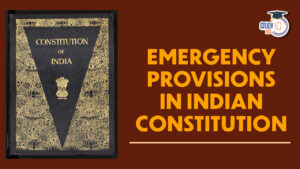Table of Contents
Tribunals
A tribunal is a quasi-judicial body set up to handle issues like administrative or tax disputes. It has various roles,
- such as resolving disputes,
- determining rights between parties,
- making decisions, and
- reviewing existing decisions.
The term “tribunal” comes from “Tribunes,” referring to magistrates in ancient Rome who protected citizens from unfair actions by powerful officials. Generally, a tribunal is any person or organization with the authority to judge or resolve disputes, regardless of its name. The Tribunals are an important part of Indian Polity which is an important subject in the UPSC Syllabus. Students can also go for UPSC Mock Test to get more accuracy in their preparations.
Tribunals in India Meaning
A tribunal is a special type of body set up to deal with specific issues and is sometimes called a quasi-constitutional body. The Indian Constitution includes rules about tribunals in Part XIV-A, which was added by the 42nd Amendment in 1976. Tribunals were established based on the recommendations of the Swarn Singh Committee. The rules for tribunals come from two articles:
- Article 323-A, which focuses on administrative tribunals, and
- Article 323-B, which covers other types of tribunals.
Evolution of Tribunals:
Tribunals are judicial or semi-judicial bodies created by law to speed up the resolution of cases compared to traditional courts and to provide expert knowledge on specific subjects. The Indian judicial system faces challenges with a backlog of cases; as of June 2021, there were nearly 92000 cases pending in High Courts for over 30 years and almost 68,000 in the Supreme Court.
This note explores the tribunal system in India, including its history, administration, and suggested reforms. In 1976, Articles 323A and 323B were added to the Constitution, allowing Parliament to create administrative tribunals for public service matters and other subjects like taxation and land reforms. The Supreme Court later clarified that legislatures could establish tribunals on any relevant topics.
Tribunals can either replace High Courts or operate below them. Some, like the Securities Appellate Tribunal, allow direct appeals to the Supreme Court, while others, like the Copyright Appellate Board, allow appeals to the respective High Court.
The tribunal system has grown over the past 80 years, starting with the Income Tax Appellate Tribunal in 1941. Many tribunals were established from the 1980s to 2010s, and the Finance Act of 2017 consolidated several of them. In 2021, a Bill was introduced to abolish nine tribunals and shift their cases to regular courts.
Importance of Tribunals in India
Regarding conflict settlement, there has always been a need for the creation of a special organisation. The need for a specialised institution to resolve disputes on particular issues arose as a result of the rise in the number of court cases, which increased the strain on the courts.
Tribunals in India are a important component of the Indian legal system because they help the courts deliver decisions on time by lightening their workload. The Tribunals are beneficial since they are committed to resolving disputes in a particular area. This lowers the costs for the system and the people involved.
Types of Tribunals in India
According to Part XIV-A of the Constitution, two types of Tribunals in India are formed.
Administrative Tribunals
It is an Indian military court. It was created in accordance with the 2007 Armed Forces Tribunal Act. The ability to have disputes over commissions, appointments, enlistments, and employment terms involving individuals covered by the Air Force Act of 1950, the Army Act of 1950, and the Navy Act of 1957 decided by the AFT has been made available. A judge and an administrative member make up each bench. The Administrative Members are retired members of the Armed Forces with the rank of Major General or above, while the Judicial Members are retired High Court Judges. The Administrative Member position may also be filled by a Judge Advocate General (JAG) who has held the position for at least a year.
There are tribunals for settling various administrative and tax-related disputes, including: Central Administrative Tribunal (CAT), Income Tax Appellate Tribunal (ITAT), Customs, Excise and Service Tax Appellate Tribunal (CESTAT), National Green Tribunal (NGT), Competition Appellate Tribunal (COMPAT) and Securities Appellate Tribunal (SAT), among others.
Central Administrative Tribunal (CAT)
- Purpose: The CAT handles service matters for Central Government employees and those working in Union Territories or government-owned corporations.
- Established: It was set up on November 1, 1985.
- Structure: The tribunal has 17 regular benches, mostly located at High Courts, with two in Jaipur and Lucknow. Each bench includes a Chairman, Vice-Chairman, and members from both legal and administrative backgrounds.
- Appeals: If someone disagrees with a CAT decision, they can appeal to the relevant High Court.
State Administrative Tribunal
- Authority: Article 323B allows state legislatures to create tribunals for issues like tax collection and land reforms.
Water Disputes Tribunal
- Purpose: Created under the Inter-State River Water Disputes Act of 1956, these tribunals resolve conflicts over water from rivers
- shared by states. A recent amendment aims to simplify the process by creating a single tribunal for multiple disputes.
Armed Forces Tribunal (AFT)
- Establishment: Formed in 2007 to address disputes related to military personnel’s appointments and service conditions.
- Structure: The AFT has a main office in New Delhi and regional offices in several cities. Each bench has a Judicial Member (usually a retired High Court judge) and an Administrative Member (usually a retired senior military officer).
National Green Tribunal (NGT)
- Purpose: Established in 2010, the NGT focuses on environmental cases to ensure quicker resolutions. It handles issues related to environmental protection and compensation for damage.
- Structure: Initially set up in five locations, the main office is in New Delhi, with others in Bhopal, Pune, Kolkata, and Chennai.
Income Tax Appellate Tribunal
- Creation: This tribunal was formed under the Income Tax Act of 1961 to handle tax-related appeals, consisting of judicial and accountant members.
Characteristics of Administrative Tribunals
- Legal Basis: Administrative tribunals are created by law and have judicial powers to perform quasi-judicial functions.
- Fairness: They must operate fairly and follow the principles of natural justice.
- Flexibility: Unlike regular courts, they are not bound by strict legal procedures and can act more informally.
Tribunals for Other Matters
Part XIV-A of the Indian Constitution contains the provisions pertaining to the Tribunals for Other Matters. Article 323-B gives state governments the authority to create Tribunals in addition to the federal government. In India, tribunals have broad authority over various topics, including taxation, foreign exchange, land reforms, imports and exports, labor issues, state laws, parliamentary elections, limits on urban property, food supplies, rent, and tenant rights.
Difference Between Tribunals and Court
Both tribunals and courts handle disputes between parties that affect people’s rights. While they have many similarities, there are also important differences. The table below highlights these distinctions.
| Courts | Tribunals |
| It is a component of the traditional judicial system, where the State provides the authority. | It is an organisation established by statute and endowed with judicial authority. |
| Unless there is an express or implicit bar, civil courts have the authority to hear any civil lawsuits. | It has the authority to hear cases of the kind granted to them by the Statute. They were created to decide situations of a specific type. |
| Court judges are apart from the executive. | The executive has complete control over the length of service, terms of employment, and other circumstances for tribunal members. |
| The presiding officer in this case has legal training. | The presiding officer could or might not have legal training. |
| The judge must be disinterested in the dispute’s topic and impartial. | The tribunal in this case could be a party to the dispute. |
| All norms of process and evidence must be followed by courts of law. | Tribunals must abide by natural justice principles, not civil procedure rules. |
| Courts can rule on whether a law is valid. | The validity of legislation cannot be decided by tribunals. |
Tribunals Drawbacks
- Tribunals have their own rules and procedures, which can sometimes overlook the Rule of Law.
- Many tribunals do not have the same independence from the executive branch as courts do.
- Unlike regular courts, administrative tribunals do not follow a standard code of procedure.
- Tribunal members come from various backgrounds, including those without judicial training, like administrators and technical experts.
- They often use faster processes to handle cases within their scope.
Tribunals Criticism
Since the members of many tribunals (including the ITAT and the National Company Law Tribunal) have been hand-picked by the Executive, the Supreme Court has frequently criticised these bodies as being instruments of the Executive.
No National Tribunals Commission (NTC) was established to oversee tribunals and ensure that they operated consistently. In the L. Chandra Kumar v. Union of India (1997) case, this notion was advanced. More criticism has been levelled as a result of lack of legal expertise and loyalty to the existing administration. The Tribunals’ meetings are frequently held in secret, which could cause problems with transparency.
Tribunals in India UPSC
Tribunals are a crucial kind of extrajudicial organisation because of their numerous benefits. Tribunals provide flexibility in contrast to regular courts, which must follow rigid rules of procedure. They provide quick justice and are less expensive. Even a layperson can easily understand the tribunals’ plain and straightforward process.
Additionally, they provide respite for the regular courts, which are already overloaded with lawsuits. However, some changes must be made to permit its seamless, effective, transparent, and accountable operation. Students can read all the details related to UPSC by visiting the official website of StudyIQ UPSC Online Coaching.


 Indian Secularism: Constitutional Provis...
Indian Secularism: Constitutional Provis...
 India Mediation Campaign, Objectives, Pr...
India Mediation Campaign, Objectives, Pr...
 Emergency Provisions in Indian Constitut...
Emergency Provisions in Indian Constitut...





















